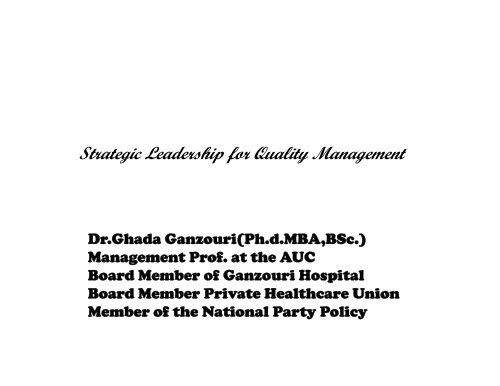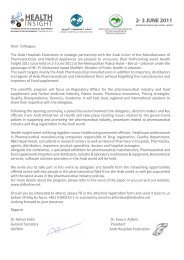Strategic Leadership for Quality Management
Strategic Leadership for Quality Management
Strategic Leadership for Quality Management
You also want an ePaper? Increase the reach of your titles
YUMPU automatically turns print PDFs into web optimized ePapers that Google loves.
<strong>Strategic</strong> <strong>Leadership</strong> <strong>for</strong> <strong>Quality</strong> <strong>Management</strong><br />
Dr.Ghada Ganzouri(Ph.d.MBA,BSc.)<br />
<strong>Management</strong> Prof. at the AUC<br />
Board Member of Ganzouri Hospital<br />
Board Member Private Healthcare Union<br />
Member of the National Party Policy
<strong>Strategic</strong> leadership For <strong>Quality</strong> <strong>Management</strong><br />
•Pitfalls in <strong>Quality</strong> Initiatives<br />
•The importance of the role of Leaders<br />
•Who are our leaders in our hospital<br />
•<strong>Leadership</strong> commitment in setting quality as a culture<br />
•<strong>Leadership</strong> role in setting quality as a strategy<br />
•<strong>Leadership</strong> role in motivating employees<br />
•<strong>Leadership</strong> role in quality improvement<br />
•<strong>Leadership</strong> role in maintaining quality
“Be<strong>for</strong>e following a leader it<br />
is wise to see if he is headed in<br />
the right direction.”
The Leader is not a quality believer<br />
Choosing the wrong person<br />
Sending the wrong people <strong>for</strong> training<br />
No allocated resources<br />
No Allotted time<br />
No Clear vision<br />
i<br />
No setting to priorities<br />
<strong>Quality</strong> function being set at very low level in<br />
the organization structure
“Where leaders Lead others will follow”<br />
“Body ygoes where head goes”<br />
• Andrew Grant<br />
“You can Not change something unless you<br />
believe in it”<br />
Steven e Covey
Definitions:<br />
•<strong>Leadership</strong> is the direction, guidance, and<br />
example given to others to get quality work done<br />
and achieve stated objectives.<br />
•<strong>Leadership</strong> is the ability to take others where<br />
they otherwise would not go or to get others to<br />
do what they otherwise would not do.<br />
•<strong>Strategic</strong> <strong>Leadership</strong> is guidance or direction<br />
<strong>Strategic</strong> <strong>Leadership</strong> is guidance or direction<br />
that is essential to meeting intended objectives<br />
or successfully implementing a plan of action.
Leaders are effective because of their impact<br />
on others’ motivation and on others ability to<br />
per<strong>for</strong>m effectively and with satisfaction<br />
◦ Delegation of authority is supported with<br />
responsibility<br />
◦ Clear communications<br />
◦ A feedback system<br />
◦ A reward and recognition system
• Do not breach <strong>for</strong> something you never do.<br />
• Come to work first, leave last.<br />
• Treat good workers friendly, encouraging<br />
and with respect.<br />
• Treat poor per<strong>for</strong>mers firmly but always<br />
with respect.
•Those of the governing body (including owners,<br />
as applicable)<br />
•The chief executive officers and other senior<br />
managers (including the healthcare quality<br />
professional)<br />
•Department leaders<br />
•Elected and appointed leaders of the medical<br />
staff and clinical departments<br />
•The nurse executive and other senior nursing<br />
leaders
To be able to achieve a culture of quality<br />
improvement , all hospital staff need to work<br />
in this direction. Leaders’ commitment to<br />
quality improvement is the main drive<br />
towards achieving such culture.<br />
We should include quality improvement as a<br />
goal in the hospital’s strategic plan
Develop the quality culture<br />
Develop culture that focus on improving<br />
per<strong>for</strong>mance<br />
Make customer the center of your culture<br />
Blame free -culture<br />
Cultivate the wanted culture and set policies and<br />
strategy to help implementing it.
Creating a Customer-Responsive Culture<br />
◦ Hiring the right type of employees (ones with a<br />
strong interest in serving customers)<br />
◦ Having few rigid rules, procedures, and regulations<br />
◦ Using widespread empowerment of employees<br />
◦ Having good listening skills in relating to customers’<br />
messages<br />
◦ Providing role clarity to employees to reduce<br />
ambiguity and conflict and increase job satisfaction<br />
◦ Having conscientious, caring employees willing to<br />
take initiative
•Help in defining both the mission and vision and plan<br />
and revise them when necessary<br />
•Shared vision with the organization and all<br />
involved<br />
•Develop a strategic plan that is aligned with quality<br />
• Annual initiatives linked to the strategic plan<br />
• Governing body and leadership education<br />
• <strong>Leadership</strong> participation in the organization<br />
pp p g<br />
wide communication of the development ,<br />
implementation and ongoing evaluation of the<br />
quality strategy
Priorities your Objectives<br />
Start with the most important objectives<br />
Act on Important and not urgent<br />
Set First things first “Steven Covey from the<br />
Seven Habits ”<br />
Translate overall objectives into departmental<br />
objectives
Empower every employee to increase<br />
productivity and improve retention<br />
•Induce team work through two-way<br />
communication and trust<br />
•Encouraging and teach staff<br />
• Develop a set of per<strong>for</strong>mance measures and<br />
aligning the organization with the quality<br />
standards<br />
•Provide the structure ,plans and policies i to<br />
accomplish the goals of the strategic plan<br />
D l f ti l g i ti l<br />
•Develop cross-functional organizational<br />
networks:
Help in prioritize implementation ef<strong>for</strong>t<br />
◦ based upon organizational functions and strategic<br />
quality initiatives to be able to impact patient<br />
outcomes<br />
Develop systems and processes<br />
◦ To help in implementing improvement programs<br />
◦ To assure reliability , accuracy and confidentiality<br />
of in<strong>for</strong>mation in conjunction with health<br />
in<strong>for</strong>mation management /medical records and QI
Communicating quality data concerning<br />
planning, measurement , and<br />
improvement (involve as many staff as<br />
possible)<br />
Story Telling<br />
Continuing i to educate and assist staff as<br />
necessary and train them<br />
Overcome resistance<br />
Allocate resources needed<br />
Facilitate change as often as necessary to<br />
assure success
Build quality skills across the organization and<br />
move away from thinking of the quality function<br />
as a department<br />
Build lifetime relationships with patients,<br />
extending care and communication beyond the<br />
office visit<br />
Move quality initiatives i i i out of meeting rooms to<br />
the front lines<br />
Reduce complexity ,utilizing process redesign<br />
skills
Infection rates<br />
Medication errors($17-19 billion /year I USA)<br />
Readmissions<br />
Complications<br />
Delays<br />
Longer length of stay<br />
Unnecessary complexity
Building Creditability and trustt<br />
Delegation<br />
Assure having an updated implementable<br />
policy and procedures <strong>for</strong> all your processes<br />
Assure allocation of resources<br />
Empowering Employees
Credibility (of a Leader)<br />
◦ The assessment of a leader’s honesty, competence,<br />
and ability to inspire by his or her followers<br />
Trust<br />
◦ Thebeliefoffollowersandothersintheintegrity,<br />
character, and ability of a leader.<br />
• Dimensions of trust: integrity, competence,<br />
consistency, loyalty, and openness.<br />
◦ Trust is related to increases in job per<strong>for</strong>mance,<br />
organizational citizenship behaviors, job<br />
satisfaction, and organization commitment.
Integrity : Honesty and truthfulness<br />
Competence: Technical and interpersonal<br />
knowledge<br />
Consistency: Reliability, predictability, and<br />
good judgment in handling situations<br />
Loyalty: Willingness to protect a person<br />
Openness: Willingness to share ideas freely
Practice openness.<br />
Be fair.<br />
Speak your feelings.<br />
Tell the truth.<br />
Show consistency.<br />
Fulfill your promises.<br />
Maintain confidences.<br />
Demonstrate competence.
Policy<br />
◦ Accept all customer-returned merchandise.<br />
Procedure<br />
◦ Follow all steps <strong>for</strong> completing merchandise<br />
return documentation.<br />
Rules<br />
◦ Managers must approve all refunds over $50.00. 00<br />
◦ No credit purchases are refunded <strong>for</strong> cash.<br />
6–24
Delegation<br />
Leader permits the group to make the decision within<br />
prescribed limits. it<br />
Routine work<br />
Specialist work<br />
Some details of your<br />
bigger plan<br />
Preparations be<strong>for</strong>e ,<br />
during or after your<br />
higher level inputs<br />
Work that can be done<br />
competently by a less<br />
expensive employee<br />
The principle is to<br />
delegate to the lowest<br />
level of competence<br />
<br />
<br />
<br />
<br />
<br />
<br />
<br />
Real leadership activities<br />
Work that you simply<br />
don’t like doing!<br />
High risk tasks<br />
One off important items<br />
Critical, urgent tasks<br />
with insufficient time to<br />
explain or control<br />
Highly confidential<br />
matters<br />
Crucial goal setting,<br />
decision making or<br />
monitoring of results
Empowerment<br />
◦ Involves increasing the decision-making discretion of<br />
workers such that teams can make key operating<br />
decisions in develop budgets, scheduling workloads,<br />
controlling inventories, and solving quality problems.<br />
◦ Why empower employees?<br />
• Quicker responses to problems and faster decisions.<br />
• Addresses the problem of increased spans of control<br />
in relieving managers to work on other problems.
Talk Straight<br />
Demonstrate Respect<br />
Create Transparency<br />
Show loyalty<br />
Deliver Results , keep commitments<br />
Get better<br />
Clarify Expectations<br />
Practice Accountability<br />
Listen first<br />
Extend trust<br />
“From Steven Covey ,Seven<br />
Habits' of successful People”
-The Healthcare <strong>Quality</strong> Handbook, Janet A.<br />
Brown, RN,C.P.H.Q 2005<br />
-The Joint Commission i Presentation<br />
“Accreditation and Surveying Techniques”,<br />
Oct,2009<br />
-<strong>Management</strong> , Stephen P.Robbins,2007<br />
.
















